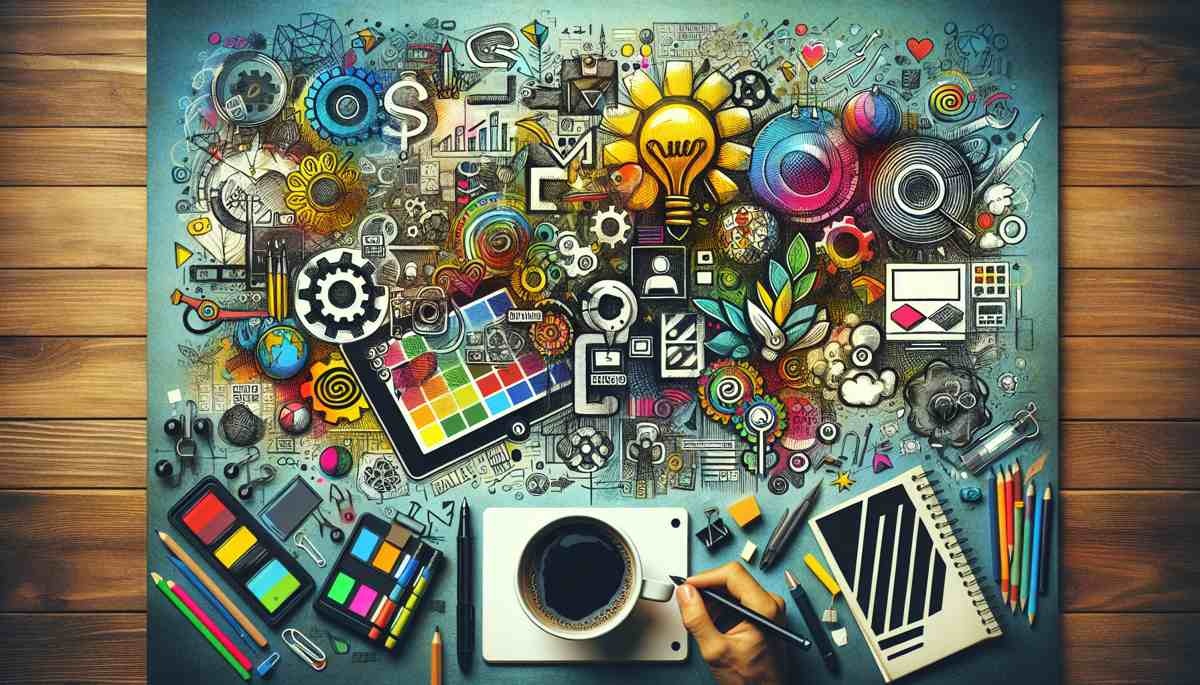Essential Tips for Logo Design for Your Website

In today’s digital-first world, a website often serves as the initial interaction between your brand and potential customers. In this context, the logo design for your website becomes incredibly crucial. A well-designed logo is not merely a graphic icon; it embodies your brand’s identity, making it a powerful tool for establishing brand recognition and a lasting impression.
Crafting the perfect logo that aligns with your brand’s values and conveys the right message is not without its challenges. A logo should not only capture the essence of what your business stands for but should also be adaptable to various online platforms and devices. As the face of your brand on the web, your logo needs to maintain high aesthetic appeal and seamlessly integrate with the overall design of your website.
To achieve this, it is essential to integrate key logo design principles into your website’s framework. By focusing on elements such as color scheme, typography, and scalability, you can ensure that your logo is both attractive and functional.
Moreover, thanks to technological advancements, designing a compelling logo has become more accessible. Tools like the Fiverr Logo Maker leverage artificial intelligence, enabling users to create professional-quality logos with just a few clicks. If you are looking to boost your website’s branding with an exceptional logo, you might want to try logo maker. This tool simplifies the design process by providing easy-to-use features while allowing you to uphold the unique vision of your brand.
In this article, we will delve deeper into essential tips for integrating logo design for your website, accentuating both its visual allure and its role in enhancing brand recognition. Understanding these fundamentals can transform your website into a powerful branding tool, ensuring a positive and enduring impression on your audience.
Understanding the Role of a Logo on Your Website
In the realm of digital branding, a logo serves as the visual cornerstone of your brand’s identity, particularly on your website. As a pivotal element, it does more than just offer visual appeal—it conveys the essence of your brand and sets the stage for recognition and engagement. Integrating a thoughtfully designed logo on your website is crucial for both first impressions and long-term brand affinity. Here, we delve into the significance of its positioning, size, and placement to achieve these goals.
Positioning
The positioning of your logo on a website is not just about aesthetics; it’s about functionality and experience. A strategically placed logo, commonly at the top left of the page, aligns with users’ natural reading patterns. This ensures your logo design for the website catches the visitor’s eye immediately, enhancing brand recall. Effective positioning ensures that the logo is the first thing a visitor notices, helping anchor your brand in their mind from the first interaction.
Size
Equally important is the size of your logo. It must be large enough to be recognizable yet not overwhelming. A perfect balance is key. The optimal size varies with design; however, a logo often fits comfortably within a header, ensuring it’s visible across various devices. This consideration secures your logo design for the website remains impactful on both desktops and mobiles, catering to the diverse ways users access content today.
Placement
Traditional placement, such as the top left, serves well, but exploring other placement options can differentiate your website. For instance, a central placement could work for minimalist designs, allowing the logo to stand out without clutter. Consistency across different pages is crucial; it ensures seamless navigation and continuously reinforces your brand identity.
In conclusion, conscious consideration of your logo’s positioning, size, and placement on your website safeguards its role in maximizing brand recognition and engagement. By aligning these elements with your brand’s visual identity, you can foster a cohesive and memorable online presence that enhances your website’s overall appeal.
Key Elements of Effective Logo Design for Websites
Designing a logo for your website is not just about creating a visually appealing graphic. It’s about encapsulating your brand’s identity through key elements that ensure your logo is both memorable and impactful across all digital platforms. Below, we explore some essential components to consider in your logo design process and how to maintain consistency, focusing on aspects like color scheme, typography, and scalability.
Color Scheme
Choosing the right color scheme is vital for establishing an emotional connection with your audience. Colors evoke emotions and convey messages subconsciously, making them a powerful tool in defining your brand image. A well-thought-out color palette not only draws attention but also ensures that your logo is easily recognizable across different devices and screens. Opt for colors that align with your brand’s personality and avoid using an excessive range of hues to maintain clarity and focus.
Typography
The type of font used in your logo can significantly impact how your brand is perceived. Typography should reflect your brand’s values and enhance the overall design without compromising readability. It’s crucial to select a font that is versatile enough for various digital formats, maintaining legibility whether viewed on a small mobile screen or a large desktop monitor. Consistency in typography across your website ensures a unified brand message and aids in creating a seamless user experience.
Scalability
In the digital landscape, ensuring your logo is scalable is imperative. Scalability refers to the ability of your logo to maintain its integrity and clarity regardless of size. As users may view your logo on anything from a large billboard to a mobile app icon, your design should be adaptable without losing important details. Vector graphics are an excellent choice for scalability as they ensure that your logo remains sharp and clear at any size.
Consistency Across Platforms
An effective logo design for a website guarantees consistency across all digital platforms. It’s important that your logo not only fits perfectly within your website’s design but also translates well onto social media, mobile apps, and any other digital space where your brand might appear. This uniformity reinforces your brand identity and creates a cohesive visual aesthetic that strengthens brand recognition.
When it comes to creating a professional logo, leveraging modern technology can significantly streamline the process. The Fiverr Logo Maker allows users to create personalized logos using artificial intelligence with just a few clicks. This tool is particularly useful for ensuring consistency and scalability in your design. For those interested in exploring this option, you might consider checking out Fiverr’s offering to try logo maker, where technology meets creativity.
Paying meticulous attention to these elements of logo design will not only enhance your website’s aesthetic but will also fortify your brand’s presence in the competitive digital space.
Logo Design Tools and Resources for Website
In today’s digital landscape, designing a logo for your website is both accessible and convenient thanks to an array of online tools and resources. Whether you’re a beginner looking to DIY or a brand seeking professional expertise, there are options to suit every need and skill level.
Popular Design Tools
For those ready to get hands-on with logo design for website, several intuitive tools can help bring your vision to life:
Canva: Ideal for beginners, Canva offers a vast library of templates, icons, and fonts, making it easy to create compelling logo designs with drag-and-drop simplicity.
Adobe Photoshop and Illustrator: For more advanced users, these industry-standard tools provide robust design capabilities, allowing for detailed customization and precision in logo creation.
Tailor Brands and Looka: These AI-powered platforms help generate professional-quality logos based on your brand’s name and style preferences, offering a quick and automated solution.
Key Resources for Inspiration
While tools offer the functionality, inspiration often drives creativity in logo design. Explore websites like Dribbble and Behance, which feature a plethora of creative designs and can spark new ideas for your logo. Additionally, Pinterest is a valuable resource for discovering design trends and color palettes that resonate with your brand identity.
Professional Help
Although designing your logo can be rewarding, collaborating with a professional might be the better route for a distinctive and polished brand image. Consider these options:
Hiring Freelancers: Platforms like Upwork and Fiverr connect you with freelance designers who can work closely with you to create a logo that aligns perfectly with your brand vision.
Branding Agencies: For a comprehensive approach, branding agencies offer expert insights and end-to-end services in crafting a logo that embodies your brand perfectly and seamlessly integrates across all digital platforms.
Making the Right Choice
When choosing the right resources and tools for your website logo design, consider factors like budget, time constraints, and the level of customization you desire. Whether opting for DIY tools or professional help, the ultimate goal is to create a logo that is both visually appealing and representative of your brand’s ethos.
By leveraging these digital tools and resources effectively, you can design a unique logo that enhances your website’s aesthetic and strengthens your brand presence in the digital sphere. Remember, a well-crafted logo is not just a symbol—it’s a powerful branding tool that communicates your brand’s values and leaves a lasting impression on your audience.
Conclusion: Elevating Your Brand with a Thoughtful Logo Design
A thoughtfully crafted logo is a cornerstone of establishing a trustworthy brand image online, especially in our digitally connected era. As the online face of your brand, a well-designed logo is crucial for conveying your company’s ethos and vision effectively. Understanding the importance of a logo design for your website involves much more than choosing colors and fonts. It requires a strategic approach that incorporates essential design elements and leverages the right tools.
Enhancing Brand Presence
By prioritizing key design elements like color consistency, typography, and scalability, your logo not only boosts the aesthetic appeal of your website but also reinforces your brand presence across all platforms. A coherent logo design ensures your brand is instantly recognizable, whether viewed on a desktop, tablet, or smartphone. This universality in logo design helps create a seamless brand experience for your audience.
Tools for an Effective Logo Design
Creating a compelling logo design does not have to be an overwhelming process. Modern technology offers a myriad of tools and resources that can assist you in developing a logo that reflects your brand’s identity effectively. With innovations like artificial intelligence, you can create a logo with just a few clicks. For instance, if you’re looking for an easy yet professional way to design a logo, you can try logo maker, which utilizes AI to streamline the design process. This tool simplifies the task, enabling you to produce a high-quality logo that embodies your brand’s vision without the need for extensive design skills.
The Impact of Thoughtful Logo Design
Ultimately, an effective logo design serves as a powerful branding tool. It encapsulates your brand’s story and values, making a lasting impact on your audience. By integrating thoughtful design practices and utilizing available resources, you can create a logo that not only elevates your website’s visual appeal but solidifies your brand’s presence in the competitive online landscape. Remember, the essence of a well-executed logo design lies in its ability to transform your website into a beacon of brand identity, fostering trust and recognition among your audience.





